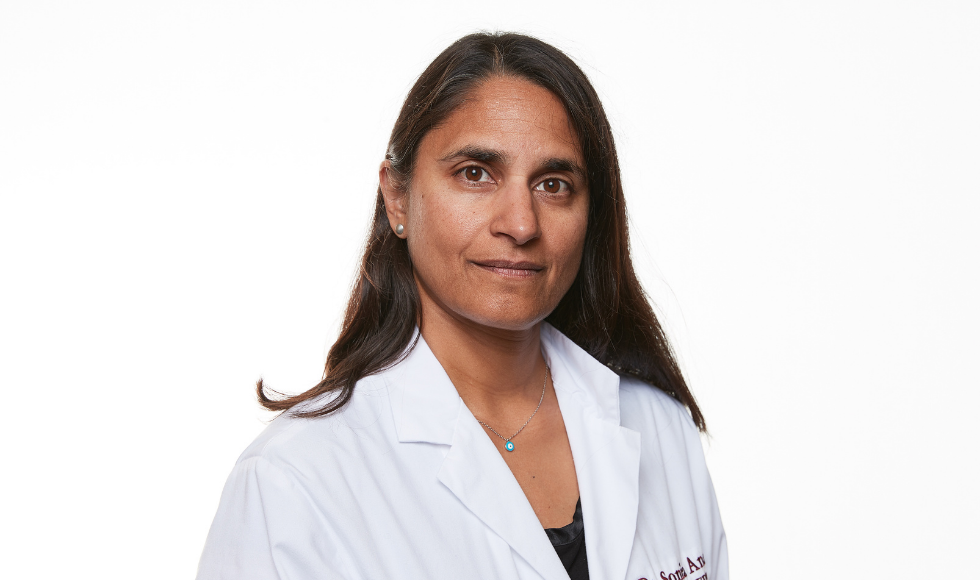GTA South Asian communities disproportionately hit by COVID-19

Sonia Anand is the principal investigator on a study that has found South Asian communities living in the Greater Toronto Area (GTA) suffered disproportionately from COVID-19 in the first year of the pandemic. (Photo by Kevin Patrick Robbins/McMaster University).
BY Fram Dinshaw
July 6, 2022
A COVID CommUNITY – South Asian study led by McMaster University researchers has found that South Asian communities living in the Greater Toronto Area (GTA) suffered disproportionately from COVID-19 in the first year of the pandemic.
The study has been published in the Canadian Medical Association Journal (CMAJ) Open.
The Government of Canada, through its COVID-19 Immunity Task Force (CITF), invested approximately $1.5 million in this study to understand vaccine confidence and hesitancy in this population that has been disproportionately affected by COVID-19.
The researchers found the Regional Municipality of Peel, home to a large South Asian Canadian community, emerged as a COVID-19 hotspot before the local rollout of vaccines starting in April 2021.
During the second wave of the pandemic in late 2020, Peel Region accounted for 23.6 per cent of Ontario’s COVID-19 cases, despite having just 10 per cent of the province’s population. The City of Brampton was the hotspot’s epicentre.
These results are from 916 participants enrolled from April 14 to July 28, 2021. Participants, recruited predominantly from vaccine centres, provided blood samples that were tested for the presence of antibodies to the SARS-CoV-2 virus that causes COVID-19. Additional information on participants’ demographic characteristics, risk perceptions and sources of COVID-19 information was also collected.
The proportion of participants with antibodies reflecting prior infection was much higher than those found in most other pre-vaccination era studies conducted in Canada at that time, with an infection rate of 24 per cent.
“It is the sociodemographic factors, or social determinants of health, which place South Asians from the Peel Region at higher risk of COVID-19, compared to the general population,” said Sonia Anand, the study’s principal investigator.
“One third of participants in this study were essential workers through the pandemic, and 20 per cent lived in multi-generational households. These factors, along with lower socioeconomic status, are the primary determinants of the higher seropositivity rates in Peel’s South Asian community, instead of any innately biological cause,” she said.
Anand, who is also a professor of the Department of Medicine, director of the Chanchlani Research Centre, and a senior scientist at the Population Health Research Institute (PHRI) of McMaster and Hamilton Health Sciences, said collecting the data on past infections is vital for governments when prioritizing health-care resources for at-risk communities.
She added that, while the media had widely reported that South Asian communities were at higher risk of COVID-19, it was important to gather what she termed “quantitative metrics” to build the evidence base and to understand what factors accounted for the higher infection rate.
“The differential toll of COVID-19 on the Peel Region was widely recognized early in the pandemic. We funded this research to get a clearer picture of the factors underpinning the vulnerability of the region’s South Asian community,” says Dr. Catherine Hankins, Co-Chair of the CITF.
“Understanding the factors that rendered any community or region a hotspot for COVID-19 will not only help us manage future pandemics, but the insights can also inform Canada’s ongoing efforts to achieve more equitable health outcomes on a population-wide basis.”
Anand said that health-care advocates had already pressured the provincial government to make Peel Region a priority area for vaccines, given its status as a COVID-19 hotspot.
“COVID-19 exposed the inequities in terms of health-care access. What we found in this study has really driven that point home,” said Anand.


